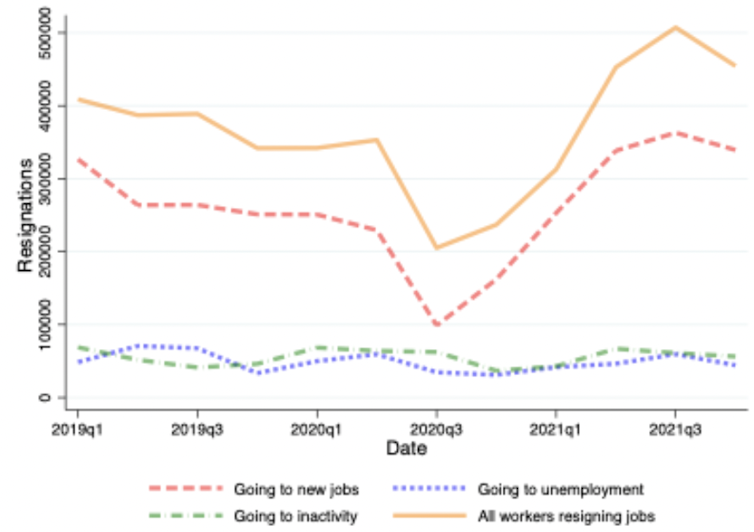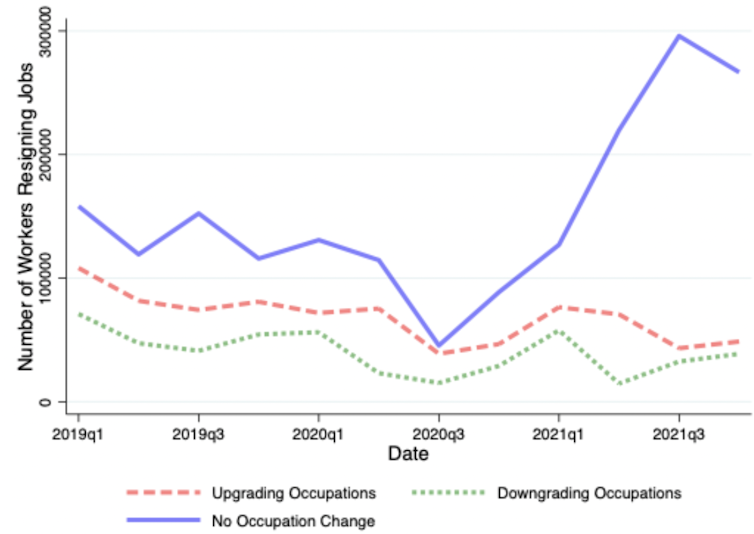
Patricia Taylor joins WM People as chair
Patricia Taylor has been appointed chair of the board of directors of workingwise.co.uk's...read more
Researchers from the University of Essex say the so-called ‘Great Resignation’ has mainly been about people moving sideways rather than upwards, with only older workers dropping out of the labour force altogether.

The great resignation is a buzzphrase that first appeared in May 2021, and has struck fear into the hearts of employers ever since. Coined in the US, the term refers to the unprecedented rise in the number of workers resigning from their jobs following the pandemic.
There has since been a huge amount of research trying to work out why this has happened. Are workers quitting work entirely, as the pandemic makes us reevaluate our priorities? Or are they quitting to pursue their dreams in a different career?
We’ve been looking at to what extent this great resignation narrative holds true in the UK using data from the Labour Force Survey by the Office for National Statistics. “Great” of course has two meanings and we’ve looked at both the magnitude of changes in resignations and whether these changes were a positive force for workers’ career progression. We also looked at whether any rise in resignations may have worsened the labour shortages faced by firms.
There was indeed a great resignation in the UK, according to the data. The chart below shows that resignations rose sharply from the end of 2020 and significantly exceeded their pre-pandemic levels in the final quarter of 2021.
However, this is not because workers decided to abandon work and leave the labour force. Instead, we are seeing a rise in workers resigning primarily to start new jobs for other employers. The only age group where there has been an increase in people leaving the labour force has been among the over-50s, who have been retiring in larger numbers than normal.
The great resignation is a buzzphrase that first appeared in May 2021, and has struck fear into the hearts of employers ever since. Coined in the US, the term refers to the unprecedented rise in the number of workers resigning from their jobs following the pandemic.
There has since been a huge amount of research trying to work out why this has happened. Are workers quitting work entirely, as the pandemic makes us reevaluate our priorities? Or are they quitting to pursue their dreams in a different career?
We’ve been looking at to what extent this great resignation narrative holds true in the UK using data from the Labour Force Survey by the Office for National Statistics. “Great” of course has two meanings and we’ve looked at both the magnitude of changes in resignations and whether these changes were a positive force for workers’ career progression. We also looked at whether any rise in resignations may have worsened the labour shortages faced by firms.
There was indeed a great resignation in the UK, according to the data. The chart below shows that resignations rose sharply from the end of 2020 and significantly exceeded their pre-pandemic levels in the final quarter of 2021.
However, this is not because workers decided to abandon work and leave the labour force. Instead, we are seeing a rise in workers resigning primarily to start new jobs for other employers. The only age group where there has been an increase in people leaving the labour force has been among the over-50s, who have been retiring in larger numbers than normal.
UK resignations 2019-21


 *Carlos Carrillo-Tudela is Professor of Economics at the University of Essex; Alex Clymo is Assistant Professor of Economics at the University of Essex, and David Zentler-Munro is Assistant Professor in Economics at the University of Essex. This article is republished from The Conversation under a Creative Commons license. Read the original article. Notes: all data is from the two-quarter longitudinal Labour Force Survey. The series shows the number of workers (aged 16-65) making a given occupation transition after resigning their last job and starting a new one in the previous quarter. Going to inactivity means the people are no longer working. A stable seasonal filter is applied to all series.
*Carlos Carrillo-Tudela is Professor of Economics at the University of Essex; Alex Clymo is Assistant Professor of Economics at the University of Essex, and David Zentler-Munro is Assistant Professor in Economics at the University of Essex. This article is republished from The Conversation under a Creative Commons license. Read the original article. Notes: all data is from the two-quarter longitudinal Labour Force Survey. The series shows the number of workers (aged 16-65) making a given occupation transition after resigning their last job and starting a new one in the previous quarter. Going to inactivity means the people are no longer working. A stable seasonal filter is applied to all series.